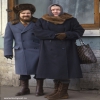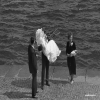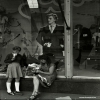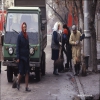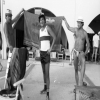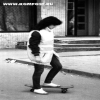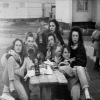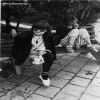
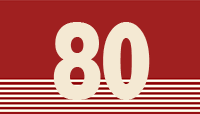
Casual
|
Already by the early 1980s, the city-folk habitually stood in long lines just for the imported "brands", talked only about the import, and even new heroes in the Soviet movies wore clothes that were difficult to find on the shelves of Soviet stores. The term "fashion" was tightly associated with the term "to get" and for a certain category of people it turned into a way of life. By the end of the eighties, after the music lover boom and changes initiated by Raisa Gorbacheva finally came some "thaw" and the female population set off to the winds, taking pop and movie images, along with their war paint for the a role model. This phenomenon immediately spread among the rest of the Soviet and from the second half of 1980s some basic pseudo trends could be identified, the origins of which can easily be sought in the circles of "black market trade ", Soviet imports of goods and in the showcases of check stores such as "Berezka" and "Albatross". There was no common understanding of the term "fashion", but it was obviously related to the fashion goods coming from different public sources. And this reality, copying situations, was expressed in the in fashion "directions": 1) "American" - made sport-tourist and denim plan, with "Texas" jeans which did not survive the fashion of their Indian counterparts, in the end transformed into "Varenki" of all types and have lost their geographical and miraculous "flavor", became something quite ordinary. 2) "Italian" - basically it could be expressed in suits, coats and accessories for "business people". 3) "German" - was expressed in a strict German-style fashion that gained acceptance in the second half of 1980 among women. A distinctive feature and a separate part of the male "style" was German footwear and sneakers "Adidas", which already for the Olympics-80 were named only as "the Soviet Adidas." 4) Socialist camp - as a legacy of official imports, among which, together with shoes and cosmetics, has left an indelible mark on fashion in knitted products ideologically linked with the Czech Republic, Poland and Yugoslavia. Since the mid-eighties, to overexposed knitted sweaters were added knitted hats of various configurations. Although, no doubt, we can distinguish a phenomena such as a short-term trend to lace in the early 1980s, probably associated with convulsions of "huts" that offered women who were getting married translucent dresses and veils. The Perestroika fashion for boiled jeans, rovers boots, leggings, flounces skirts, greased back hair and jackets with padded shoulders ... Taking into account that there was not that much of these mods and meeting them on the street was rare. The tastes of the young were tried to be satisfied by the products of the socialist camp and co-perestroika period, but it could not break and obscure the basic, typical for the Soviet trend of the postwar period. The yard fashion to the working jacket, in common referred to as "padded jacket" on the one hand has become a symbol of the trouble of the 1970-80s, and on the other - the youth fashion of district companies. They were embroidered, hemmed, decorated and even riveted, making it the subject of the present fashion, or rather a phantom of fashion, which existed in the Soviet Union and disappeared with its death. And I should note that, in today's youth’s anti fashion analogues of unsightly and fun things of the Soviet, it has become quite popular among today's hipsters.  go back to "Fashion" go back to "Fashion" |


